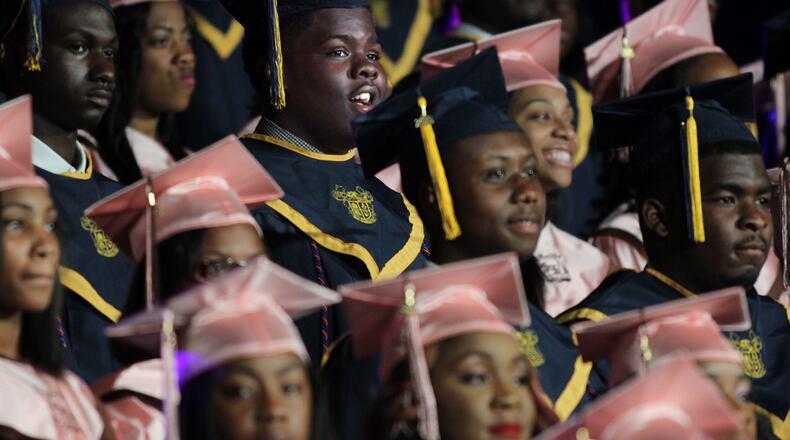Georgia high school students are continuing to graduate in increasing numbers, with four out of five students finishing with a diploma for the first time in half a decade.
Even as enrollment has grown, the graduation rate has continued to climb after a sharp decline early in the decade, according to new figures released by the Georgia Department of Education Wednesday.
The rate for last year's senior class topped 80 percent for the first time under the federal measure known as the "four-year adjusted cohort graduation rate." That measure only counts students who graduate within four years of starting high school, and requires school districts to track and document the graduations of students who move away. When it was first imposed, Georgia's rate was above 80 percent, but, as in other states, it plummeted.
In 2012, the baseline year under the new measure, the rate was 69.7 percent. The rise to 80.6 percent in 2017 was part of an unbroken chain of modest annual increases, up from 79.4 percent the year before.
In the past, some of the increase has been attributed to schools' growing familiarity with the new federal measure, and improved administrative capacity to track students who've transferred from the district so their graduations can be confirmed. The elimination of a mandatory high school graduation test may also have played a role.
The state education department attributes the steady growth to targeted intervention through better use of student data and to improved school safety, making for a better learning environment. The agency also credits local districts' use of "personalized" learning. Academically advanced students can take Advanced Placement or International Baccalaureate courses, or they can enroll in college courses, simultaneously earning college and high school credit. The career-focused can also take these dual-enrollment courses in subjects like welding or industrial mechanics. And all students are expected to pursue one of the state's "career pathways," which offer an introduction to fields like architecture, hospitality or marketing.
The goal is to make school seem relevant to more students, said state school Superintendent Richard Woods.
“Georgia’s teachers, districts, and schools are personalizing education for each individual student, making sure those students are motivated and encouraged to stay in the classroom because they’re engaged in their learning, because they see how their education connects with their future goals.”
Dana Rickman, researcher with the Georgia Partnership for Excellence in Education, a nonprofit, nonpartisan policy organization, said slow and steady improvements are an indicator of solid success. She said an emphasis on personalized learning and data is a plausible driver of Georgia's gains, given the track record of the Complete College Georgia program. She said universities such as Georgia State have seen success in that program by using personal data and "predictive analytics" to identify students who are at risk of stumbling in college, then driving counseling and other resources to them.
And a focus on career can make school more “relevant” and “engaging,” she said.
She warned, though, that improving the graduation rate from here will be hard work: “At this point, you’ve really gotten the low-hanging fruit, and it’s really a grind to get that last 20 percent.”
None of the public schools that scored a perfect graduation rate are traditional neighborhood schools. Among them was Drew Charter School in Atlanta, DeKalb County’s Early College Academy and Gwinnett County’s School of Mathematics, Science and Technology. Some are open to all students, but all require some kind of application process that isn’t present at normal schools. Others with a 100 percent graduation rate, such as Columbus High School, are magnet schools with entrance requirements.
“We get really good kids and along with that we get really great families and a strong alumni network,” Principal Marvin Crumbs said.
The school in Muscogee County has relatively few challenges with poverty, given that just one in five qualify for free or reduced-price meals in a district where three out of four qualify. But Crumbs said the school’s biggest advantage is a culture of success that has endured over the decades. Alumni from before World War II visit to reinforce values of excellence and service. Students must volunteer at least 20 hours in the community annually, and most exceed that, Crumbs said. He said the PTSA is a strong one that brings money and volunteers into the school. He described most parents as working class. “They just have a commitment to education.”
About the Author
Keep Reading
The Latest
Featured



